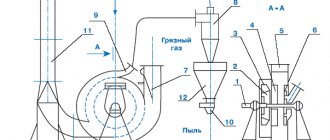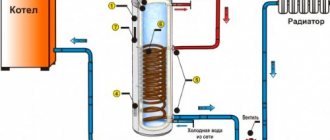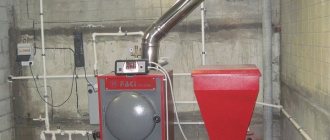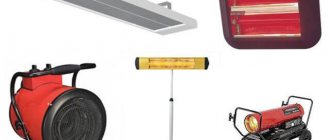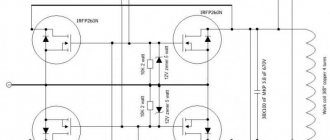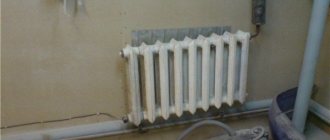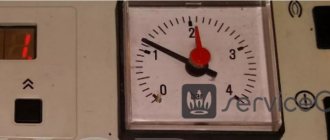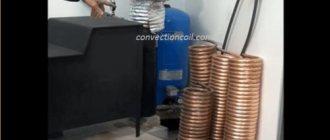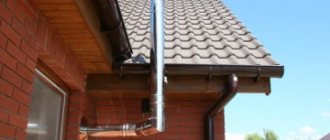Eliminating backdraft
If there is no draft in the chimney, you need to know a few basic rules to get rid of it.
Never start this process, even if you notice that the cravings have become a little worse, immediately sound the alarm, take steps, look for the reason. Do not forget to clean the chimney on time, make sure that no debris or other objects get into the shaft. It is recommended to immediately install a visor as protection.
Installing a deflector will help eliminate backdraft in the chimney. This device looks like a fan, which will spin due to the wind and “suck” air into the channel. Additionally, you can install a regulator, which also allows you to get rid of the problem with “return”.
In general, based on the original reason for the loss, do this or that work
Please note that no device can correct the design errors of the channel; here you will only need to rebuild or modernize the chimney
What can cause cravings to worsen?
If you do not know what the draft in the fireplace depends on and for what reasons it can worsen, it is important to know about a number of the most common reasons, which are as follows:
- The chimney can be equipped with various tees, elbows and other connecting elements located along the channel through which the smoke passes;
- Installation errors or possible incorrect placement of the valve;
- Initially, the diameter and cross-section of the chimney pipe were incorrectly selected;
- If there is no draft in the fireplace, the outlet may be located below the ridge on the roof. Perhaps this has already provoked the “overturning” of this element;
- In the immediate vicinity of the chimney there are taller and larger houses, structures and other buildings. Thus, very high or, on the contrary, low pressure can cause deterioration in the operation of the traction mechanism.
The chimney must be raised and installed at the highest point of the roof
Pollution and precipitation should not penetrate inside the structure
It’s interesting to know: in order to perform diagnostics yourself, you just need to turn off the entire heating system and measure the amount and layer of soot and soot accumulated on the walls of the chimney. The thickness of such a layer should not exceed 2-3 millimeters.
Carrying out the device and extension
In order to establish the operation of the traction mechanism, one of the following options can be applied in practice:
- Extend the chimney until the optimal size and dimensions are achieved;
- Use additional fittings and parts;
- Supplement the design with a purchased electric smoke exhauster;
- Buy traction stabilizers.
Cleaning and maintaining the product is a rather complex and labor-intensive process that allows you to maintain the functionality and productive operation of the device.
Diagram with measurements and dimensions of electrical variation
Important: make sure that the pressure in the inside of the chimney varies from 10 to 20 Pa. In order to determine this criterion, it is recommended to use special devices, for example, you can use an anemometer, the price of which depends on the chosen model and manufacturer.
Interesting to know: the instructions for extending the chimney say that the optimal total length of this element should not be less than 5-7 meters, depending on the design features and number of storeys of the house. In this case, knees and narrowings should occur as rarely as possible.
Expert tips and advice
Installation was carried out on a brick chimney
Making a deflector with your own hands
To make sketches of the device parts, you need to measure the internal diameter of the chimney and calculate their dimensions.
You can make a deflector for any pipe size yourself
To do this, we present several defining relationships:
- the width of the diffuser is determined depending on the internal diameter of the pipe by multiplying by 1.5;
- the width of the umbrella should be 1.7 in relation to the same parameter;
- the same coefficient is used to determine the height of the device.
After calculating the dimensions, you can begin making part developments. They can be done on whatman paper or any other thick paper.
The paper parts need to be assembled into a finished product using paper clips or a stapler, and try it on the chimney pipe. If necessary, make adjustments to fit the product to the pipe.
To make the deflector, galvanized or stainless steel sheets with a thickness of at least 0.5 millimeters are used.
Using the development of the parts, you need to transfer their contours to sheet metal and cut them out with bench scissors.
Assembly is carried out in accordance with the preliminary design.
Tools and materials for making a deflector
To make such a device, you will need the following:
- steel sheet;
- metalworking scissors for cutting metal;
- drill with drills of the required sizes;
- hammer;
- pliers;
- fasteners;
- marker for marking parts on metal.
The procedure for making a deflector
The production technology consists of sequentially performing a number of operations:
- Transferring the contours of parts onto a metal sheet using a marker. You need to get the following parts - cap, stand, diffuser and outer cylinder.
- The blanks for the cap, diffuser and cylinder are rolled to size. Connections are made with rivets or screws, and sometimes semi-automatic welding is used.
- To install the cap you will need strips of metal. They are made from waste from cutting the main parts. You need to drill several holes on the cap and secure the parts with rivets.
- The opposite ends of the strips are secured to the diffuser in the same way.
- The resulting product is fixed to the shell.
Making devices to enhance traction with your own hands
It’s good when a person has money and can buy himself several nozzles for the chimney, but what to do when there is no opportunity to get a modern mechanism, however, there are tools and several metal plates in the garage? The answer is simple - design it yourself.
Among the tools you will need: a square, metal scissors, a tape measure, a hammer, pliers, a drill, self-tapping screws (15 mm), a galvanized sheet of metal with a thickness of 0.3-0.5 mm and several improvised materials for fastening and an old fan, more precisely, its blades.
Draw a layout of devices to enhance traction
The first thing you need to do is draw a layout of the future device. Circuit drawings can be found on the Internet. After accurately transferring the dimensions onto a galvanized steel sheet, the following actions are performed in strict sequence:
- Using a grinder or metal scissors, the main parts of the weather vane are cut out;
- The constituent elements of the weather vane are assembled according to a diagram in strict sequence and secured with rivets or self-tapping screws;
- Next, you need to secure both cones (in most schemes this point is skipped because the “masters” believe that it can be ignored). In fact, it is highly recommended not to ignore this point, so as not to provoke ruptures of the cones in strong winds;
- Now all that remains is to attach the fasteners and the fan to the device. Using fasteners, the device is attached to the base of the chimney. The fan also performs the function of increasing traction.
Wind vane
At this stage, the manufacture of the weather vane is considered complete; all that remains is to attach it to the chimney. It is fastened with self-tapping screws or rivets. Remember that this device requires regular maintenance: from time to time it must be cleaned of soot and accumulated condensation if you do not want the accumulated moisture to fall on the waterproofing layer inside the pipe.
Fireplace hood
Fireplace ventilation is a dome-type hood. It got its name for its resemblance to the air duct element of a classic fireplace. Today, fireplace hoods have become especially popular, because with their help you can not only clean the air from combustion products and food odors, but also create a cozy kitchen interior. Devices of this type are corner, wall, island and inclined. A wide selection of these designs allows you to place them in kitchens with any design lines from classic to modern and high-tech style. Dome structures have a lot of advantages and do an excellent job of cleaning the air.
Advantages of dome ventilation
Dome hoods are a classic option for kitchen ventilation. They owe their popularity to undeniable advantages over other devices, namely:
- Universal design. Domes do not need to be masked or built into furniture; they fit perfectly into any interior, adding sophistication and comfort.
- High performance. Fireplace hoods for kitchens belong to the class of flow-through ventilation systems; they have high power and performance.
- Easy to install. Installation of a dome vent does not require any special knowledge or skills. You can install it yourself by following the instructions.
- Affordable price. A wide variety of models allows you to choose a dome in any price category, which makes it accessible to almost all consumer groups.
Causes of poor chimney draft
From time to time, fireplace owners notice a deterioration in the performance of their heating device. Naturally, they don’t know what this is connected with. Experiments with changing fuel usually also lead to nothing. Experts say that the cause of poor fireplace performance is poor draft.
Causes of poor chimney draft
"Classic problems":
- The pipe diameter is too large or small. The pipe must be the correct size. If its diameter exceeds certain standards, then reverse draft occurs. Bring the fan close to the chimney, if its blades begin to move, it means you have backdraft. A pipe that is too narrow leads to a reduction in thrust to critical levels.
- Rotating elements and bends in the pipe. The chimney must be straight, otherwise you will have to install a chimney draft amplifier. Extra turns and bends significantly reduce this parameter.
- Lack of tightness. This problem often occurs in brick fireplaces as a result of poor construction technology. When a small hole appears in the wall, it begins to work on the principle of a black hole, sucking in air due to the pressure difference. The presence of additional air negatively affects the traction force. This is the same as placing a fan to the side of the upward air.
If none of the above problems are similar to yours, then an amplifier will help solve your traction problems.
Smoke draft deflector
Step-by-step instructions for creating a brick chimney with your own hands
Building a high-quality brick chimney is not an easy task and it is very important to carry out the masonry so that everything is airtight, fireproof, and every seam plays a big role here. The priority direction of the functioning of the chimney is the removal of smoke and fumes from burnt fuel using draft, which not only draws out, but also supplies air flows into the firebox, and due to this, the combustion process is supported and ensured
Do-it-yourself brick chimney construction diagram
The big advantage of such a chimney is that it has good draft in all weather conditions and has an increased service life compared to metal pipes. Let's look at the question of how to build a brick chimney with your own hands according to all the rules.
We advise you to study in more detail the recommendations: what to make a chimney from in addition to this article.
Brick chimneys are laid in three steps:
Step 1. Carrying out preparatory work and laying the foundation.
Brickwork for the foundation of the future smoke exhaust duct
At this stage, you need to carefully familiarize yourself with the construction drawings of the future chimney duct. For an ordinary and traditional wood-burning stove, complete masonry is required; for a brick chimney for a gas stove, a metal pipe made of a specialized alloy will definitely be required as an addition. Before you begin laying out a brick chimney, you should build a foundation. Construction is carried out from solid brick or reinforced concrete.
The second stage of constructing a brick chimney with your own hands. Masonry
The chimney is built at a height of five meters or not lower than the roof ridge, as this plays a big role in draft. This type of chimney is laid exclusively with specialized fire-resistant or solid red brick. To bind them, a solution of cement and sand or limestone is used, and for places with particularly high temperatures, a specialized mixture is needed, used for stove masonry.
To break off the required piece of brick, you will need a grinding and cutting machine and a marker (felt-tip pen) for measuring. Using these tools, it is possible to create plates that are absolutely accurate in size, which will be needed in the field of otter, as well as cutting.
Brickwork chimney for a gas heater
When constructing such a smoke exhaust duct, it is imperative to leave specialized openings for cleaning.
Holes at the top of the smoke duct made of brick for smoke exit and cleaning
The inside walls should have a perfectly smooth and even surface, and the corners should be 45 degrees. It is best to plaster the inner walls for smoothness, since soot will settle more on a rough surface, thereby worsening traction. This may cause a fire, which is unsafe. Also, many experienced stove makers recommend whitening the stove not only inside, but also outside, which will allow you to immediately determine where smoke and soot can seep in.
Stage 3. Fastening and thermal insulation.
If the chimney is built near a wall, it needs to be secured - this will be more reliable. To do this, you need to use metal anchors at a distance of thirty centimeters. Where the chimney will be connected to the ceiling, as well as the roof, it is imperative to place non-flammable material or glass wool, thereby reducing the risk of fire.
The brick chimney should be half a meter above the roof ridge. The upper part of the smoke exhaust duct should be insulated and covered with a specialized roofing finish or brick for cladding.
Fastening brickwork to the wall using anchors for reliability
If the chimney is made according to all technologies, it will be strong, safe, reliable and will last a long time. All these stages are preserved if you need to build a chimney for a solid fuel boiler made of brick.
Video: stages of building a brick chimney
You can line the chimney with bricks yourself, following the advice, and save on calling professionals. The main thing during construction is to build the right drawing and have free time. You should not rush, speed is not the best indicator here, you need to focus on the quality of the masonry.
Traction and possible accidents
First, about traction, and about those processes with which many owners of heating devices may be familiar first-hand.
What is traction?
Air circulation is a natural process that allows oxygen to flow into the combustion chamber and then release exhaust gases through the pipe. The movement of air and gases in the chimney occurs due to the lower density of the heated air. For this reason, a pressure difference occurs in the lower and upper parts of the channel.
Draft in a chimney is natural ventilation, consisting of exhaust and inflow. Hot gas, which has excess pressure and lower density, tends to the area where it is lower - upward. Cold air coming from the street takes up the free space. Combustion in the firebox is provided by air that continuously enters the chamber from the room, and then “travels” along the chimney channel and goes outside.
Backdraft
Reverse draft is a similar process, but the movement of gases or air is exactly the opposite. This situation occurs when the pressure at the top of the channel is higher than at the bottom. Reverse draft is a stable, but reverse circulation: in this case, flue gases return to the room along with the air that enters the chimney from the street. There are quite a lot of reverse thrust provocateurs. These include:
- mismatch of system elements - height, diameter of the vertical part of the chimney and parameters of the heating device;
- errors when designing a chimney: low vertical height, incorrectly selected cross-section, presence of horizontal or inclined sections, uneven walls;
- violation of tightness, narrowing of the channel due to soot, some kind of obstacle near the chimney;
- problems with the exhaust hood in the room, or with the general inflow;
- channel freezing.
Rollover traction
This is another possible phenomenon. When the flow of gases decreases, the draft in the channel also weakens. During this period of time, combustion slows down and the flame darkens. At the moment when circulation stops, a “thrust overturn” occurs. This is what is called a sudden release of smoke into a room. As a rule, it is one-time.
The reasons for the unusual situation are errors made during the construction of the device or chimney, the quality of the firewood and external factors: these include increased humidity, changes in atmospheric pressure, or the strength and direction of the wind. Such “tipping over whims” are typical for fireplaces with large, open fireboxes. These fumes may occur periodically, but they are not emergency events.
Making a deflector with your own hands
The sizes of the deflectors are different chimney pipes.
The walls of the upper cylinder take the wind pressure and direct the air around; smoke suction is achieved by sliding along the inner surface of individual jets. The deflector cannot be classified as a fan, since the device has a simple shape and does not have working mechanisms.
The contours of the parts that were calculated and plotted on the drawing are drawn on the cardboard and cut out. Using patterns, parts are transferred to metal with the addition of 1.5 - 2 cm along the edges of the lines for ease of assembly. Structural elements are obtained in expanded form after cutting with metal scissors.
A hacksaw is used to cut strips of metal or corners to connect parts into a finished product. The prepared parts are bent and rolled in accordance with the drawing. During assembly, the elements are superimposed on each other and connected with rivets.
Required Tools
During production, materials and tools are used that do not require professional skills from the master:
- rubber or wooden mallet;
- scissors and hacksaw for metal;
- ruler, tape measure;
- chalk for drawing lines on the metal surface;
- electric drill, rivet gun;
- metal drills;
- pencil and regular scissors.
The material is thin galvanized steel, a metal strip or a small section corner. The size of the rivets is selected in accordance with the diameter of the drill. Nuts and bolts are used for installation on the pipe.
Size calculation
A drawing is made on paper, which indicates the key dimensions for creating a pattern for a weather vane-draft amplifier for the chimney.
Ratio when calculating sizes:
- the deflector height is 1.7 d;
- the width of the cap is assumed to be 2 d;
- The diffuser width is taken to be 1.3 d.
The symbol d indicates the diameter of the chimney (internal). A different size ratio will result in poor efficiency.
Installing the deflector
After installation, the deflector is bolted to the roof so that it is not blown away by the wind.
Homemade and purchased models are assembled into a finished product below, before installation on the pipe. The aerodynamic structure is bolted to a round metal asbestos pipe; usually, 3 holes are made in the pipe for this purpose. If there is slight play, a clamp is used.
An adapter is used to mount the deflector in a brick pipe of rectangular or square cross-section. The device is tested after installation. The spark arrestor is made independently from a thin metal mesh or stainless steel sheet.
The diameter of the structure must be larger than the outlet of the pipe so that the deflector does not fall inside the channel and block the smoke exit. Rotary draft controls do not work well in cold regions with heavy snowfall. Icing interferes with the operation of the device. The devices are installed in accordance with technical standards and requirements.
Types of amplifiers
Deflectors are aerodynamic devices that specialize in deflecting air flow. With their help, you can adjust the traction force to the required parameters. The deflector fan works on a very simple principle: it sucks air from the atmosphere and directs it inside the chimney. The disadvantage of the device is its absolute helplessness during a quiet hike without wind.
The most common and effective deflectors are the designs of Grigorovich and Volpert. Modern improved deflectors are based on their prototypes. The most common designs are: round chimney nozzles (“Woppers”), star-shaped (“Shenards”) and H-shaped (multi-tiered). When choosing a deflector, carefully look at the material from which it is made. It should be stainless steel - a material that is durable and reliable.
Rotary flue turbines
Rotary turbines are mechanisms that are placed on top of smoke ducts. The principle of operation is similar to a fan, since they use wind energy to increase the pressure inside the pipe. Advantages of rotary turbines: they cover the chimney pipe and prevent the entry of precipitation. The device does not work in calm weather.
The most popular brands: Turbomax, Turbovent and Rotowent. Turbovent products are not suitable for installation on ducts for removing flue gases from furnaces.
It is also necessary to ensure that the temperature of the outgoing gas does not exceed a threshold of 250 degrees (these are standard requirements, which may differ for different models). Rotary pipes are installed for gas heating boilers.
Chimney weather vanes
Chimney weather vanes are a device for protecting the chimney on the leeward side. The model is characterized by good resistance to the negative effects of precipitation, a long service life and the presence of protective mechanisms for smoke exhaust. During the operation of weather vanes, one drawback was noted: they cannot cope with strong winds, and weather vanes also require careful maintenance - regular lubrication (especially in winter) and cleaning of soot and flue gases.
Smoke weather vane Duck and Dog – video review
The weather vane fan works on the principle of a stabilizer: it reduces the effect of strong wind on the draft in the chimney or enhances it in the absence of movement of gas masses in the atmosphere. The type of device in question is excellent for wood-burning fireplaces.
Chimney smoke exhausters
Smoke exhausters are electric heat-resistant fans for smoke exhaust. It is recommended to install these devices for adjusting the traction force only for narrow pipes. For its operation, access to an electrical network with a power of 220 V is required. Modern smoke exhausters have several upgrades, thanks to which the problems of reverse and weak draft are solved. The electric mechanism has no drawbacks; it works perfectly in calm and windy weather.
Caps and umbrellas are decorative elements for chimneys that do not solve the problem of low draft. After their installation, owners of heating devices noted additional problems: the formation of condensation on the surface of hoods and umbrellas, as a result of which the fan of the above devices quickly became unusable.
Thus, a wide variety of mechanisms for increasing traction cope well with the problem posed. The above models, in addition to smoke exhausters, have one drawback in common: they are too dependent on weather conditions. Therefore, to increase draft in the chimney, it is better to choose an electric smoke exhauster.
Manufacturing of devices to enhance traction
Types of fireplace fans
Depending on your wishes and individual characteristics of the heating installation, you can buy and install one of the following structures:
| Variety | Description and features |
| Deflector | It is distinguished by its strength, durability and resistance to rust and corrosion. The installation acts as a reflector or an element projecting the direction of air flows. Traction force increases due to the reflection of flows from the roof and side walls. Disadvantages include the ineffectiveness of the fan in calm conditions. However, in this case, the capsizing of such a device is completely excluded, even in very strong, squally and gusty winds. The main selection criteria are compliance with the chimney diameter and calculation of the wind load. |
| Vane | One of the simplest and most inexpensive options. Its functionality and the influence of traction force directly depend on the intensity of the wind. The design consists of a head and a wing with small dimensions. The design is also complemented by a special blade, which fixes and secures the weather vane to a given section of the chimney pipe. A weather vane is most often used to increase the level of draft in solid fuel boilers operating on simple logs or purchased briquettes. |
| Rotary turbine | The operation of such mechanical means is carried out by rotating turbines from wind flows. Due to the presence of special attachments built into the design, rotation is carried out exclusively in one direction, regardless of the direction of the wind itself. The advantages of this type include high-quality protection against various dirt, leaves, foreign objects and precipitation getting into the inside of the chimney. Such amplifier fans are capable of removing air efficiently, which is especially important during the non-heating season. Suitable for solid fuel and gas boilers with a maximum permissible temperature limit of 250 degrees. |
| Electric smoke exhauster | This variation is intended for stoves and fireplaces running on solid fuel. The advantages of such devices include their versatility in operation (in conditions exposed to high temperatures, the formation of large amounts of condensate, soot and other combustion products). The maximum permissible temperature for such devices has a limit of 800 degrees. Work and operation are carried out using special temperature sensors, which, if necessary, can both slow down and increase the fan rotation speed. |
Deflectors for hoods
This is a fairly common option for forced ventilation. A deflector is an aerodynamic device that is installed above the chimney. It increases draft in the chimney due to changes in air flow. The essence of its work is the pressure drop when air flows around an obstacle, as well as the principle of changing air flows. It turns out that its shape allows you to increase draft in the chimney. Made of stainless steel, they are not afraid of corrosion, resistant to acids and high temperatures.
Note! Despite its simplicity and low cost, the deflector is ineffective in calm weather. The device does not operate from electricity or any other power source, but is completely dependent on wind load.
It cannot be called a full-fledged fan, since the deflector has a simple shape, without working mechanisms
But, there are types of smoke deflectors designed specifically for chimneys
It cannot be called a full-fledged fan, since the deflector has a simple shape, without working mechanisms. But, there are types of smoke deflectors designed specifically for chimneys.
Types of deflectors:
- Wolpert deflector.
- Grigorovich deflector.
- Round or spherical deflector.
It is the round deflector that can create rotational movements under the influence of wind and remove smoke from the room. But, again, the disadvantage of the product is that it is ineffective in the absence of wind. The operating principle of this draft amplifier for ventilation pipes and chimneys is demonstrated in the video*
In addition, weather vanes, umbrellas and similar structures are often installed on chimney pipes. But they can't do everything that a high-temperature chimney fan can do. Let's look at how they work and what makes them special.
Smoke fan
The chimney exhaust fan is a heat-resistant electrical device. It is mounted directly on the chimney to increase draft in the chimney pipe. It is important not to confuse a chimney fan with a fireplace fan, which is needed to supply air to support combustion. Here the operating principle is different. To put it simply, a chimney fan is an electric motor with blades that forcefully pull smoke out of the chimney and direct it outside. For full operation of the fan, power supply from a 220V network is required.
In fact, a fan in a chimney to improve draft is somewhat reminiscent of a deflector, but its operation does not require wind force at all. He works constantly, doing his job perfectly. In addition, you can find economical models on sale. They operate in two modes: when there is a strong wind outside, rotation occurs naturally, without the use of electricity. And in calm weather the electric motor starts. This is the ideal solution for a chimney.
Which is better - a smoke exhauster or a blower?
When the traction turbine is integrated into the heat generator by the manufacturer, such questions do not arise. Adding an exhaust fan to a conventional direct combustion boiler is another matter. You must understand that in this case the smoke exhauster solves only one problem - creating a vacuum in the firebox and increasing draft. There are a number of negative points here:
- Without an electronic control unit, performance will have to be adjusted manually. Automatic maintenance of coolant temperature is excluded.
- When air is supplied through the open ash chamber door, the fan will force the boiler to operate at maximum. Setting up a long burn mode will not be easy.
- In the event of an emergency stop of the impeller, fuel combustion will not stop, since gases pass freely through the volute or the body of the smoke exhauster. Air enters the firebox, increasing the likelihood of overheating.
- The impeller and internal surfaces of the unit become covered with soot, which must be removed. The rate of sticking depends on the moisture content and resin content of the wood.
Blowing machines always work in conjunction with a controller, so the problems listed above do not exist:
- the blower changes performance and turns off at the command of the control unit, the coolant heats up to the set temperature;
- during the combustion process, the ash pan door is hermetically closed, air is supplied through a separate channel;
- when there is a power outage, the air channel is automatically closed by a gravity damper;
- the impeller blades do not come into contact with hot smoke and soot.
Now let’s compare the cost of a traction fan and a blower fan, not taking into account the price of the controller. A smoke exhauster for a TT boiler up to 30 kW will cost 90 USD. e., supercharger - 60-65 cu. e. The difference is due to the design features of the exhaust unit - hot gases should not overheat the electric motor, plus the impeller is made of metal (when pressurized, it is made of plastic).
Behind the mounting flange of the unit there is a small impeller designed to cool the electric motor
The installation complexity of the units is approximately the same. Installation of the discharge volute involves cutting out an opening in the ash pan door, and the smoke exhauster involves disassembling or cutting out the pipe. It is easier to install a roof hood, but you will have to pull a long cable.
Types of deflectors
There are several types of deflectors. They differ from each other in shape and number of parts. At the same time, you can choose the materials that are used to create them to your taste. It could be:
- Copper
- Cink Steel
- Stainless steel
Their shape can be very diverse: from cylindrical to round. The upper part of the deflector structure may have a cone-shaped umbrella or a gable roof. The device can also be equipped with various decorative elements, for example, a weather vane.
Let's take a closer look at several varieties:
TsAGI deflector
A structure whose parts are connected by flange or other means. This device is made from stainless steel, less often from galvanized steel. Its feature is its cylindrical shape.
Round volper
Its shape resembles the TsAGI deflector, but its main difference is the upper part. This device is most often installed on chimneys in small extensions, for example, in bathhouses.
Grigorovich deflector
If the site is located in an area with low winds, then such a device will provide excellent traction for many years. Experts call it a modified version of the TsAGI deflector.
Disc Astato
This type of device is distinguished by its simplicity and efficiency. This open-type deflector is made of galvanized or stainless steel, which improves traction efficiency in any wind direction.
H-shaped deflector
Its design is particularly reliable, since the deflector is made of stainless steel, and all parts are connected using the flange method. It can be installed in areas with any wind direction.
Weather vane deflector
This version of the device is the most popular and widespread. It has a rotating body on which a small weather vane is attached. The construction is made from stainless steel.
Rotating deflector
This device allows for maximum protection of the channel from clogging with debris and precipitation. Rotation occurs in one direction only. It is worth noting that it is necessary to monitor its condition, since in case of icing, as well as in calm conditions, the deflector will not work. Therefore, many people install it on gas boilers. It is also used as a rotary turbine, which is necessary for ventilation of residential and office spaces.
In addition, there is a Khanzhonkov deflector. However, it is currently not used, since more modified models of devices can be found on the market.
Design Features
Devices of this type come with horizontal and vertical smoke emission. Their body is made from galvanized steel or epoxy-coated steel, which are not susceptible to environmental influences. The design includes 2 impellers located on the engine, one of which is designed to remove smoke, the second is for self-cooling of the engine.
The fireplace fan kit may include an air flow regulator. This accessory allows you to select the optimal engine rotation speed in the following modes: ignition, constant fire, frying meat (for barbecues). This device is capable of operating in an environment from 0 to +200C.
The fireplace smoke exhauster is equipped with a single-phase or three-phase motor with insulation degree F. It has a thermal protection system with an automatic restart function. It is equipped with an impeller, the characteristic feature of which is the presence of forward-curved blades. To ensure the longest service life of the product, its design includes rolling bearings.
It is also important that the furnace fan is equipped with lifting lugs. This helps to simplify the process of lifting it and installing it on the chimney from the fireplace as much as possible.
